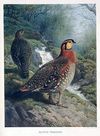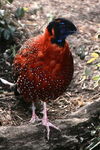Genus Tragopan
Blyth's tragopan pheasant - Blyth’s Tragopan pheasant is the largest of all the tragopans. Like most pheasants the male is brightly colored. It is recognized by its rusty red head, yellow facial skin, and that it is spotted with small white dots on its back called ocelli. A black band extends from the base of the bill to the crown couple with another black band extends behind the eyes. Like the rest of the tragopans, males have two pale blue horns that become erect during matting . Its lappet, a decorated flap, hangs from the throat and is brightly colored. This lappet can be expanded and exposed during mating season as well . Females are not as brightly colored as the male tragopan, for they don’t need the extravagant appearance to attract a male counterpart. Overall they are dark brown with a mixture of black, buff and white mottling . Their simple and dull look is a protection mechanism from other animals. It also allows the females to protect their young that are in the early stages of life.
Cabot's tragopan pheasant - the cabot's tragopan is an endangered species
Western tragopan pheasant - The male is very dark, grey and black with numerous white spots, each spot bordered with black and deep crimson patches on the sides and back of the neck. The throat is bare with blue skin while the bare facial skin is red. They have a small black occipital crest. Females have pale brownish grey upper parts finely vermiculated and spotted with black, and most of the feathers have black patches and central white streaks. Immature males resemble females, but are larger in size with longer legs and variable amount of black on head and red on neck.
Temminck's Tragopan - Its appearance resembles the Satyr Tragopan, but unlike the latter species it has all red upperbody plumage and orange collar. The diet consists mainly of berries, grass and plants.



